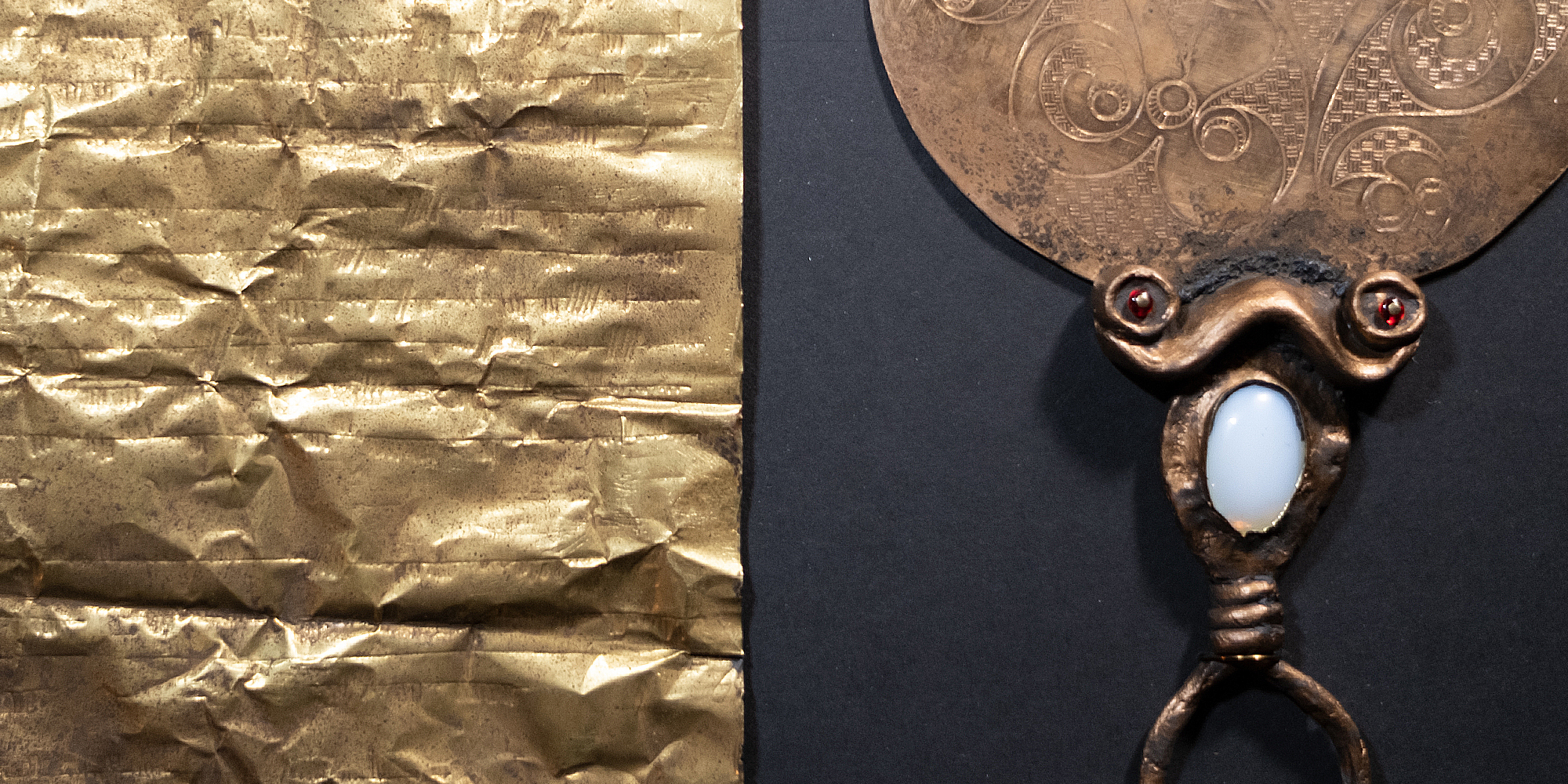Award inducting Lanea inghean Uí Chiaragáin into the Order of the Opal, inspired by ancient magical tablets and British Iron Age mirrors. Words, design, and production by me.
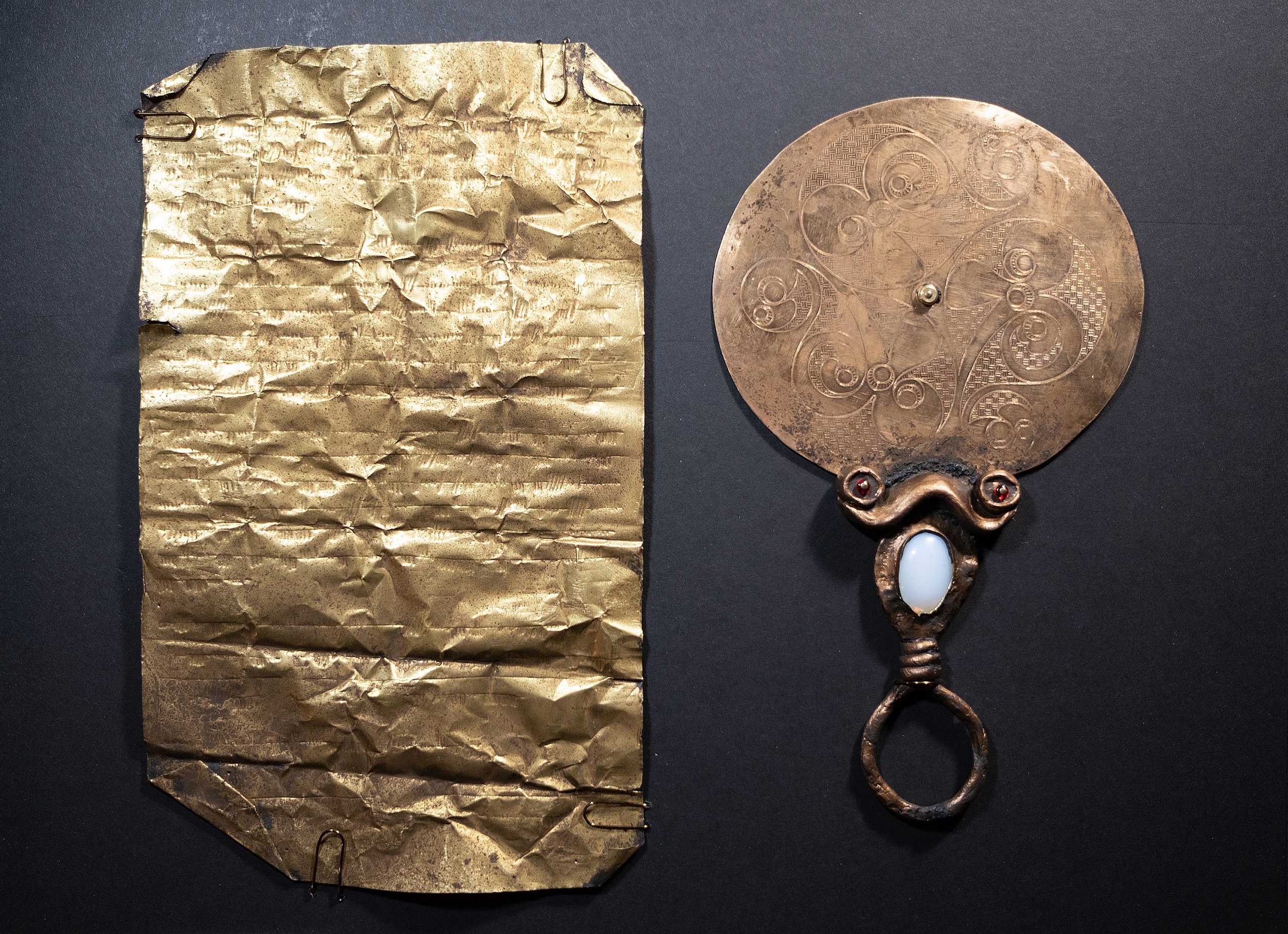
A memorandum to Bríg, she of the threefold aspect,
from those who bear witness to
the fierce capacity, ability, and generosity of
Lanea inghean Uí Chiaragáin
We ask that in your wisdom you lift her up,
as We do here, to the Order of the Opal.
Pray lend her your fire,
as she champions those who help.
Pray lend her your healing,
as she soothes those who aid.
Pray lend her your poetry,
as she inspires those who serve.
Just as this metal shines and its gem glows from within,
so let her gleam and light be recognized.
Read here on the twenty seventh of August,
Anno Societatis LVII.
Awarded and inscribed by
Cuan and Adelheit
Rex and Regina
Presented with permission by
John West and Graçia Esperança de Sevilla
Baron and Baroness
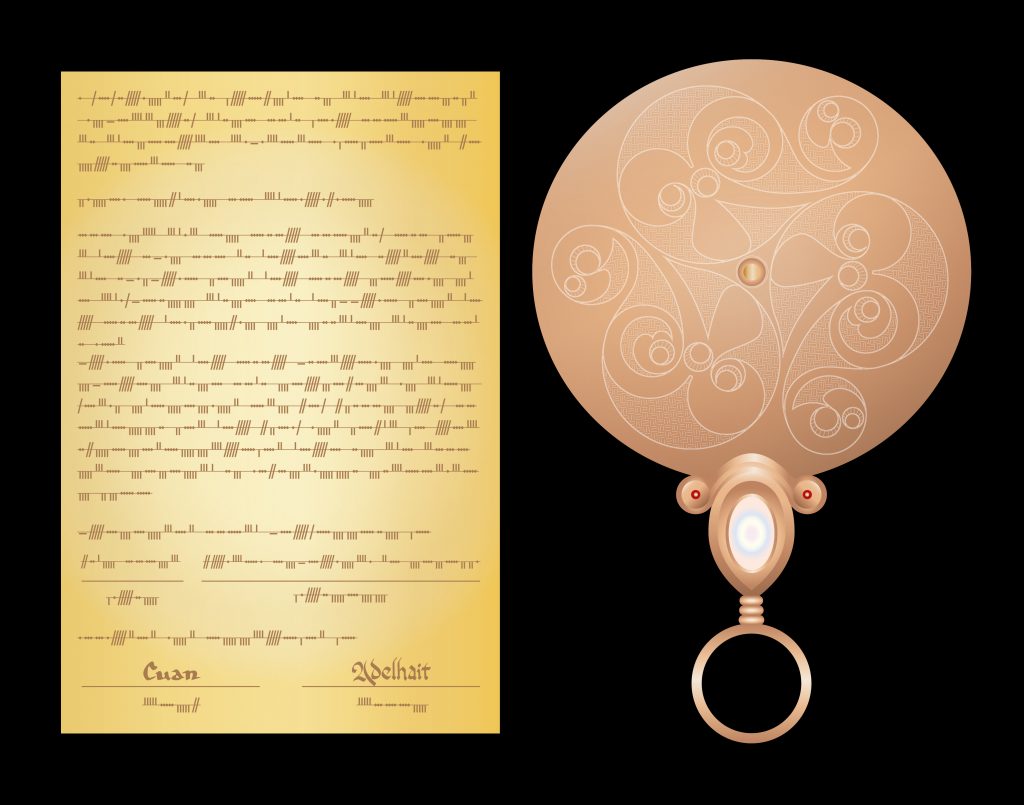
If you’ve ever watched or visited British gardening programme like The Chelsea Flower Show, you’ll know that the designers of competition gardens submit to the judges a document which includes, among other things, what’s basically a “story” of their garden, setting out who who precisely it was designed for and how that dictated their choices.
For a scroll like this one, I found myself composing the same thing: a story of this design, a object biography of its “creator” and why “they” created what they made.
This scroll is a story of rebellion. It’s a story of endurance, of championship, of strength.
It’s a story of magic.
the concept
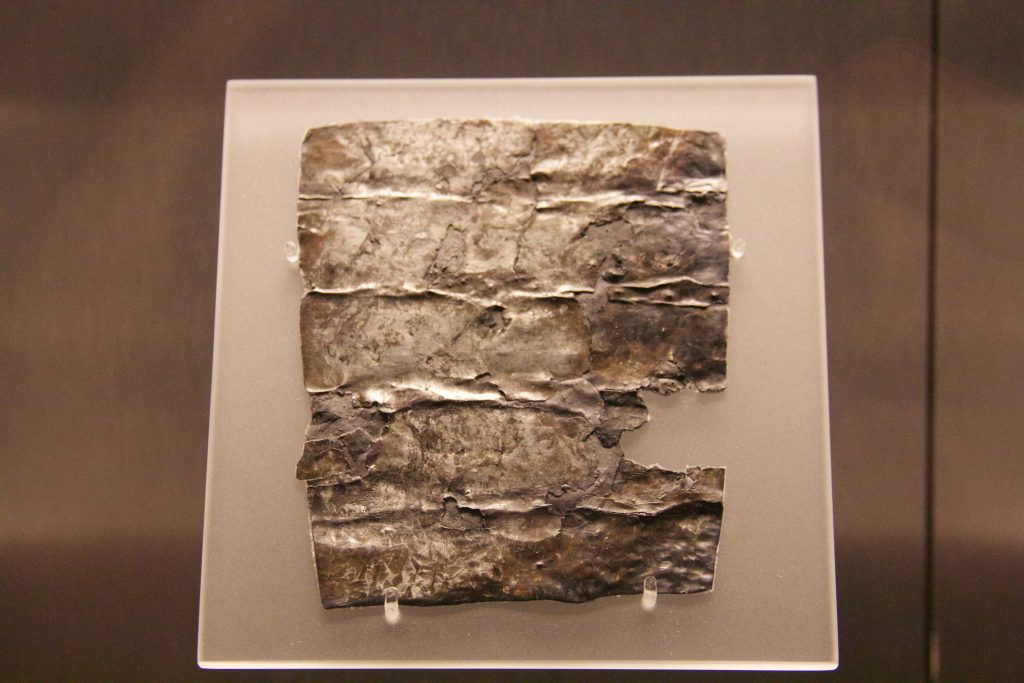
(image Mike Peel/CC-BY-SA-4.0)
As soon as I accepted this assignment, I immediately thought of the funny-sad concept of being “cursed with competence”. It nestled easily in my head alongside the aphorism “no good deed goes unpunished”, and together they sparked an idea.
Let’s be brutally honest: Although the SCA is a volunteer organization, it would disingenuous to say that these concepts never hold relevance. Even with the best of intentions, service can be a many-edged sword. My first thought was that it might be entertaining to create a curse tablet or related magical item to protect Lanea against frustrating situations.
I was positive she would appreciate the warm regard and humor behind the idea, so I started researching Romano-British curse tablets. Yet as I thought more about it, no matter that I knew she would find it funny, a curse didn’t feel right for a scroll text. Even if it were intended for her benefit, it was too negative for a positive occasion.
Further research opened up to me the larger world of lamellae and amulets, upon which the Romans and others in the Mediterranean world also inscribed prayers. Lanea’s work is driven by passion, so perhaps an impassioned prayer might be fitting?
At the same time, I had been researching Iron Age British mirrors, and I found some research that referred to their potential magic use1.
And with those two ideas in my pocket, I was off.

object biography
The term “object biography” is used in academic fields like art history and museum studies, and encompasses a mindset in which an artifact’s provenance is more than simply about where or when it was made; its fuller life story is important, from creation to who used it and when and where it travelled, and this greater context leads to greater (and more interesting) understanding.
With these two ideas in mind, the lamella and the mirror, almost without trying I began to develop their object biographies. As I researched, I imagined how these two pieces came about and how they might have become interred together.
I imagined about a woman in the early days of the Roman occupation, feeling ✨Ways✨ about the work a friend was doing. I thought about her feelings of protectiveness, and her feelings of pride, about her feelings of support.
I thought about how she might have decided to craft a spell both to help the friend in her work and to protect her friend from being used ill. She would have petitioned a certain deity, someone important to her who she thought might be willing and able to help. She might have used a lamella to convey her words to the deity, and she might have used a mirror to focus her will, and she might have used a precious gem to gain the deity’s attention and as recompense for her aid.
In doing so, this imaginary Romano-British woman would have combined the British use of the mirror with the Roman/Mediterranean use of lamellae, and British art with Roman use of language. The tools of the colonizer deployed alongside her own native tools, pushing back against an oppressive force while working within it. We have all sorts of examples of blending of the two cultures within the Romano-British world, including the integration of British and Roman deities, and I love the idea that this synthesis can reclaim power.
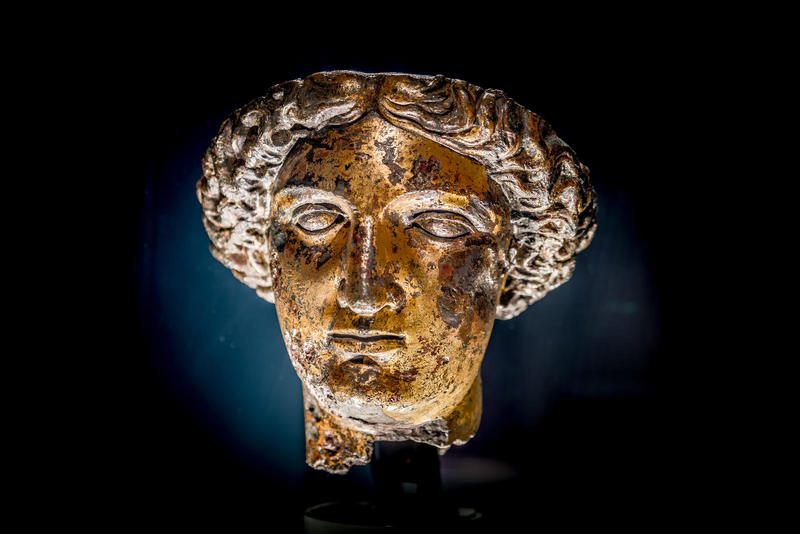
The combination of the two, lamella and mirror, used to work a spell to aid a friend’s service and protect her against those who might use those efforts against her, is an object biography that captures my imagination, and I wanted to make it real. I thought it would be a fitting honor for Lanea’s interest in the British Iron Age, her support of her friends, her passion for justice, and her unending service of those who need it. I’ve been friends with Lanea for almost twenty years, and for her I was willing to be a little (a lot) extra with this scroll. If anyone would appreciate everything that went into this project, she would.
THE LAMELLA
a prayer
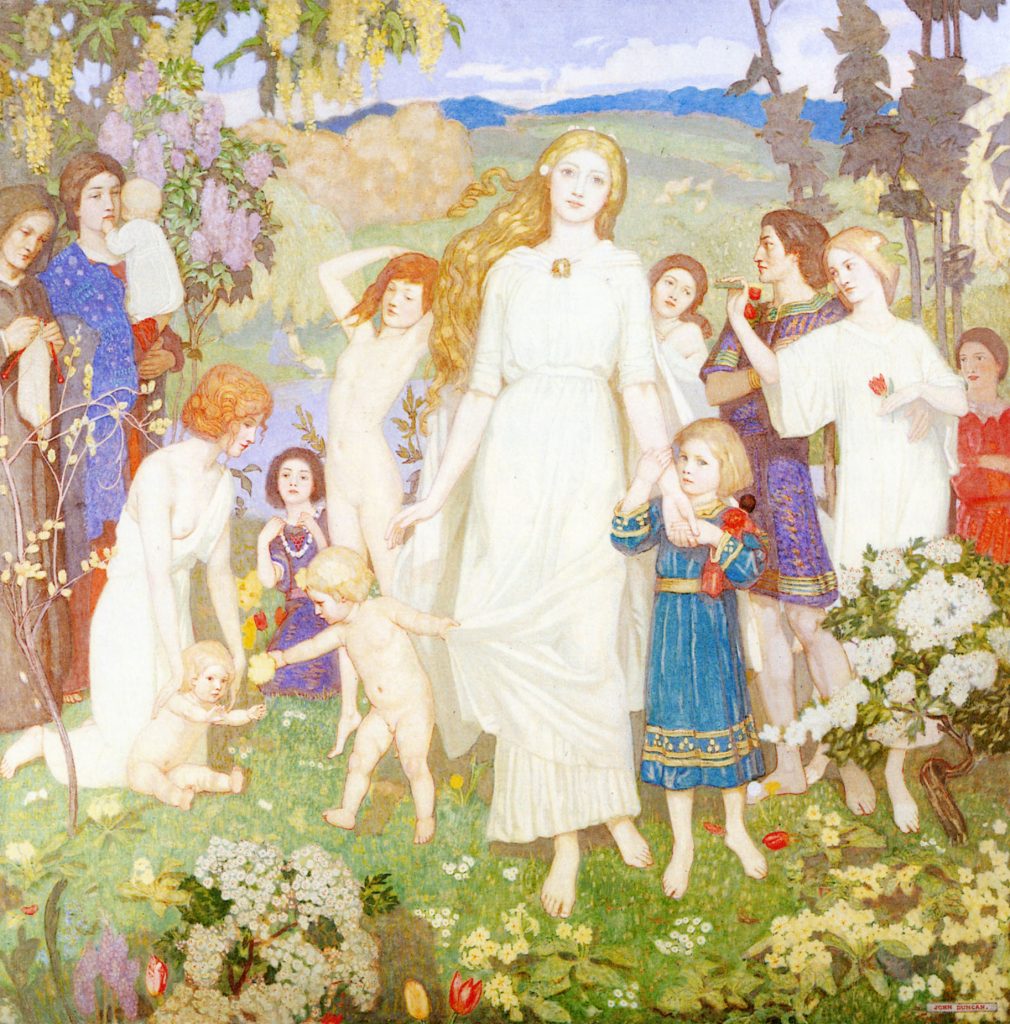
Lanea’s fav is the goddess Brigid, so she was my first (and only) choice of deity. (Although Brigid is known as a Very Irish Goddess, she appears on lists of Native British deities, so I went with it.)
While I was indeed writing a prayer, I ended up borrowing some of the language of Romano-British curse tablets from Bath. Specifically, I borrowed the introductory phrase “a memorandum” 2, and the petition “we ask that you” 3.
The simile about material sympathy—that the glow and gleam of the objects’ material is a testament to and an enhancement of Lanea’s service—was inspired by this paper from 2019 4, which talks about sympathetic magic in Greek and Latin curse tablets.
And of course, three is the theme of this whole thing. My research suggested many things that the goddess Brigid is known for (the internet didn’t always agree with itself, can you believe it?), but the commonalities were inspiration/poetry, fire and smithing, and healing/sacred wells. Integrating those with the different ways she was described as a triple goddess, I had the triad of my sacred litany.
researching lamellae
I read a lot of papers and looked at a lot of extant lamellae to get an idea of their overarching physical commonalities. Curse tablets like those in Bath were usually made from lead, but taking into account the principle of “material sympathy” mentioned above, I wanted something more rich and glowing. So I decided to slide over to the golden lamella side of the equation. (But because I’m not made of dollars, I used brass instead of gold.)
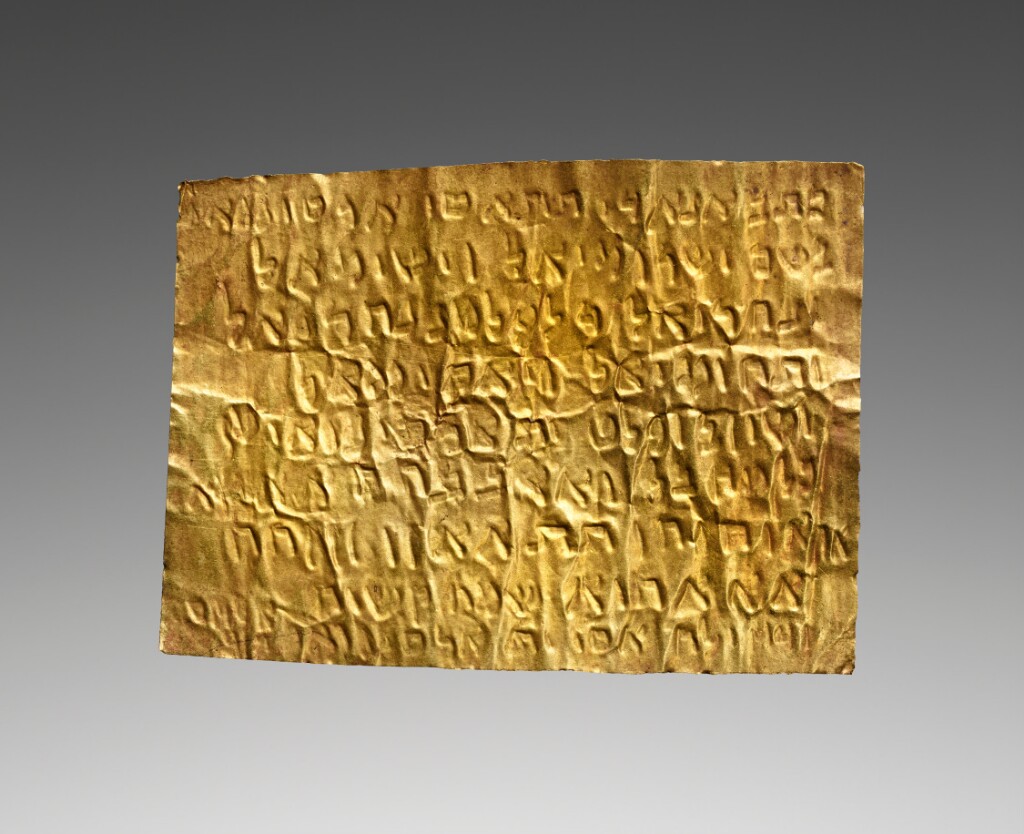
While the tradition of incantations on lamellae throughout the Roman period is strong and covers a wide range of motivations, my most helpful visual references for this project were two gold lamellae in the Getty, both shown at right and described by Roy Kotansky 5 6 (in whose niche I seemed to be playing, based on how much his name came up while researching), which are prayers for healing.
In spite of the change in alphabet, I decided to stick with the key layout features of the original texts, as I saw them: left aligned, scripta continua, fill the line.
Not all lamellae come to us folded, but for an object of this size it made sense for the imaginary supplicant to fold it for internment alongside a mirror.
The result is not the cleanest lamella extant, but let’s (imagine) assume the (fictional) museum decided it was too dangerous to try cleaning it any further, and is displaying it as is.
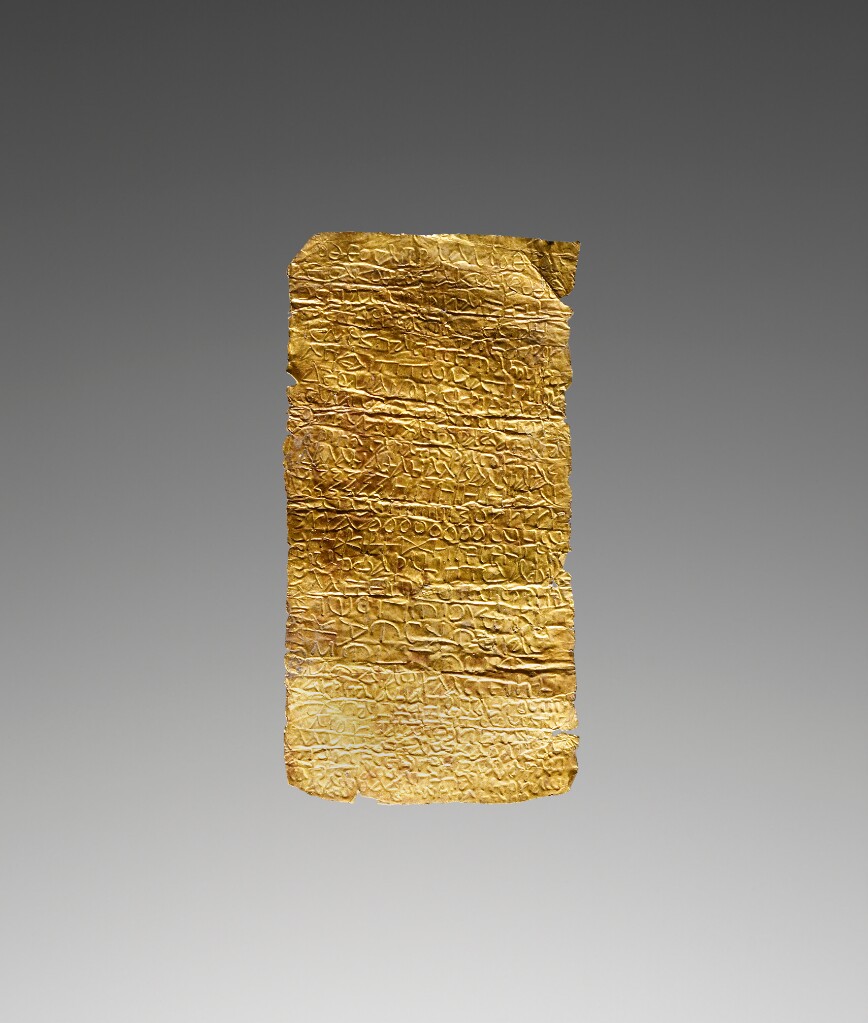
alif beth gamma
In a coincidental burst of convergent evolution, Kolfinna Valravn and I happened to be planning out similar scrolls at the same time.
This meant we could bounce ideas off each other, and resulted in, among other things, a night of Extreme Transliteration Hilarity which resulted in the two of us acting like the kids at summer camp who are giggling to the point of tears long after everyone else has gone to bed. It was madness. It was amazing. It was necessary.
I mention this because:
a) friends are great
and
b) having a laugh made my orthographic problem-solving feel a whole lot easier.
The problem?

So ideally, there would be a non-Roman language I could translate the text into—or, rather, have translated—because part of the inspiration for this scroll’s object biography is a woman taking the magic of the colonizers and turning it toward a distinctly native goddess, and it would make more sense if the writing were a part of that.
But if I wanted to use Irish, (which would have been a nice way to integrate a bit more Ireland into this scroll), my research suggested the furthest back I could trace the language was to Primitive Irish in about the 4th century. Meh.
However, after a lot of deliberation and the aforementioned laughter session with Kolfinna, in the end I decided to transliterate English into Ogham. That made the alphabet several centuries too late, but the spirit would be a lot more visually resonant than anything using Roman letters, and that was important to me.
It was extremely common to mix languages, transliterate, and include magical symbols in lamellae 7. Typically the languages of magic in the Roman Empire were Greek or Latin 8, but a few curse tablets from Bath and Uley may have been transliterated Celtic 9, and some Jewish lamellae contain Hebrew phrases rendered with Greek letters 10.
On the whole, it seems like the magical intention of the writing was the important part, more than the local accuracy of the writing itself. I like the idea that our theoretical supplicant thought eschewing the alphabet of the occupying force when speaking to Brigid would get a better, more magical result.
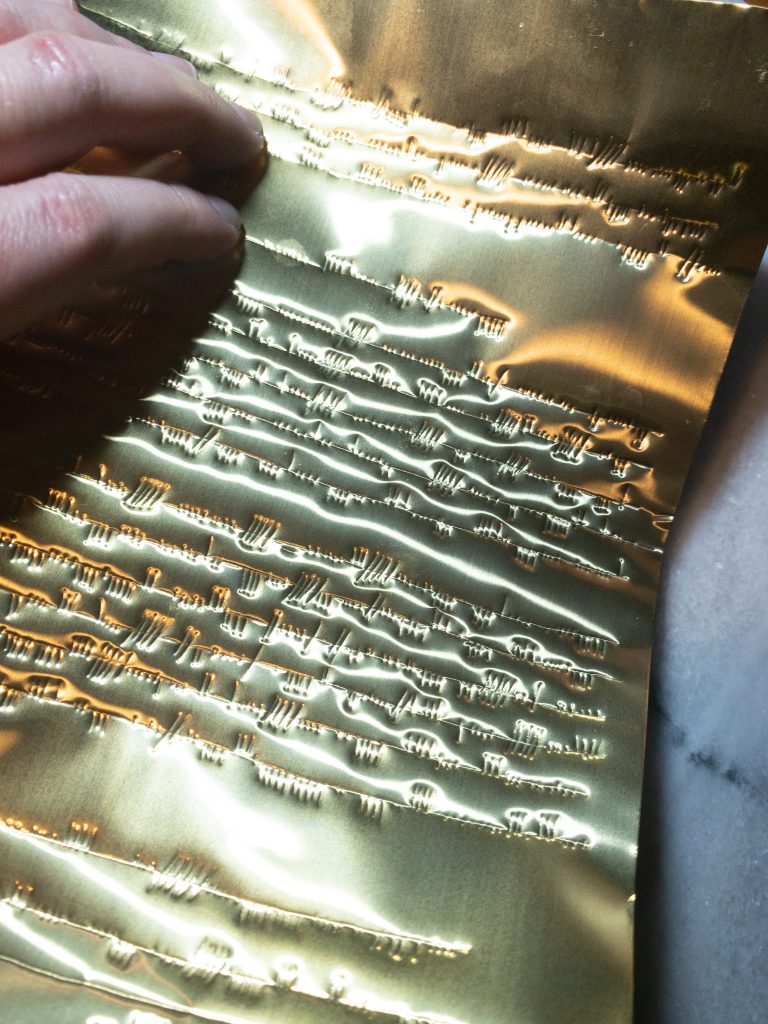

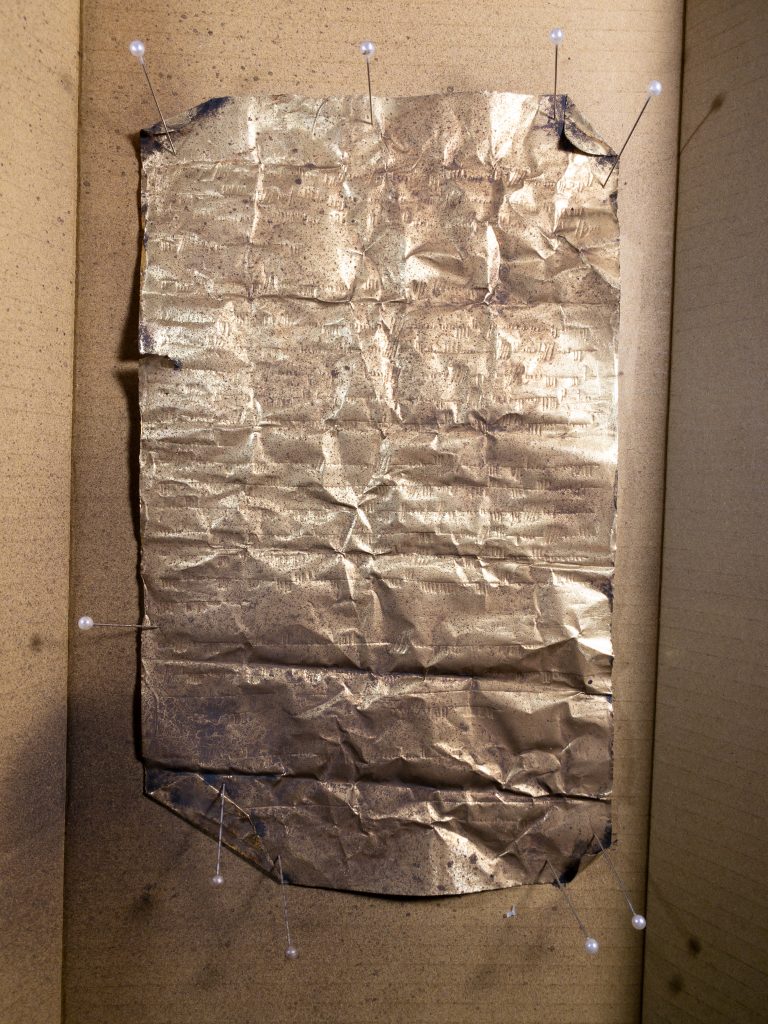
THE MIRROR
designing spirals
Since the prayer was dedicated to Bríd and her triple aspects, and indeed included a litany of three within it, I decided a “tri-roundel” 11 layout would be most appropriate. That way, the rhythm of the form would echo the rhythm of the prayer.
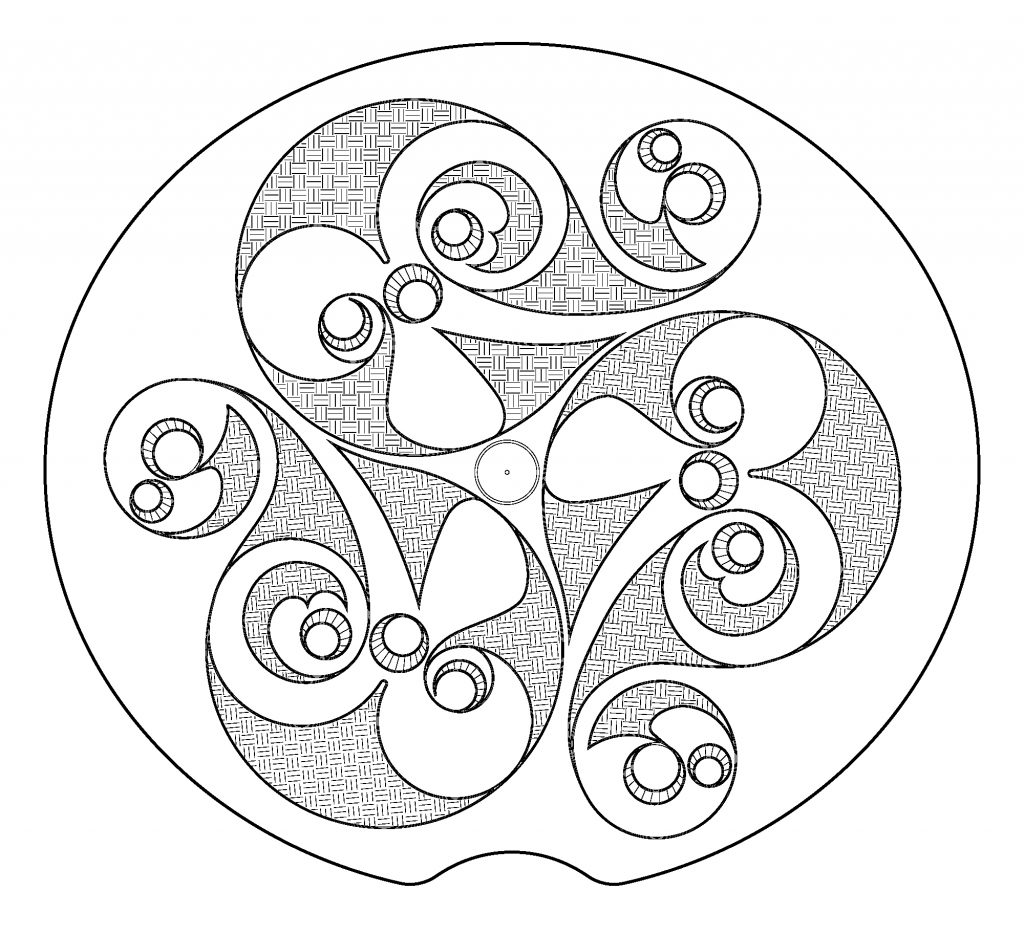
Judy Joy has done a lot of work with what scholars have come to call “mirror-style”, referring to the specific ornamentation on mirrors and some other artefacts such as scabbards. In doing so, she acknowledges the basic individual motifs set out by 20th century scholars while being critical of and re-assessing their typological judgements based, among other things, upon “aesthetic taste” 12. Her work aligns with my personal feelings on the overwhelming efforts of 18th, 19th, and 20th century art historians to assign worthiness judgements based on shaky subjective parameters, so I found it particularly relevant.
In order to describe “mirror style” with less subjectivity, she has developed criteria to describe not simply its overall appearance but its rules of construction 13. That made it possible to design an ornament for the face and be assured that while the overall result was original, it would fit easily among extant artifacts.


Beyond the larger silhouette, in studying the hashmarks in the Desborough mirror I noticed that their median angle flips on the midline of its face. Which makes sense, since mirrors broadly display vertical symmetry on the whole 14. So even a mirror’s general layout might not easily lend itself to vertical symmetry, the hashmarks might.
I also noticed that toward each point of the fields in which they were placed, the hashmarks were perpendicular to the point, rather than leading toward it.
These details seemed to carry over through a number of mirrors, indicating to me that it’s an integral part of the style.
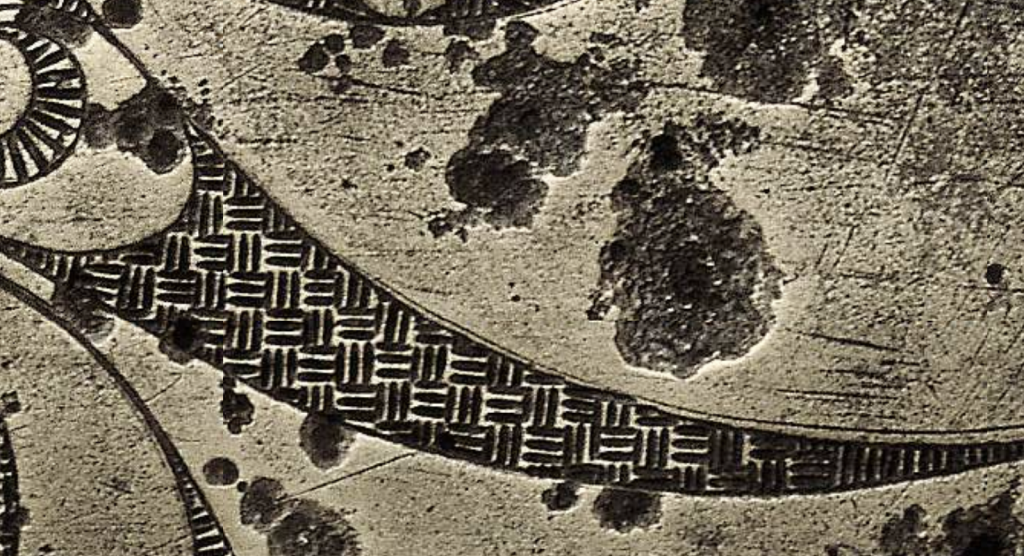
(There are, of course, variations. The mirrors were carved over a spread of time and area, so naturally there are variations. They were also made by real people with a variety of skill and attention to detail. The Aston Mirror has been described as being carved by “a craftsman of limited technical ability–and perhaps with unsatisfactory tools-whose chief aim in this piece was to achieve the greatest economy of time consistent with his powers.” 15 As in, with limited ability and maximum efficiency. Hardly the description of a masterwork to suggest a type specimen.)
Both of these facts meant that the hatchmarks needed to be placed with care. Each teeny line was assessed and its location approved. The result is a pattern fill which provides texture for each positive field type, contrasting with the shine of the negative fields, lending a further disorientation to the wavering play of light and shadow in the polished bronze. There is an otherworldliness to the world seen in the mirror.
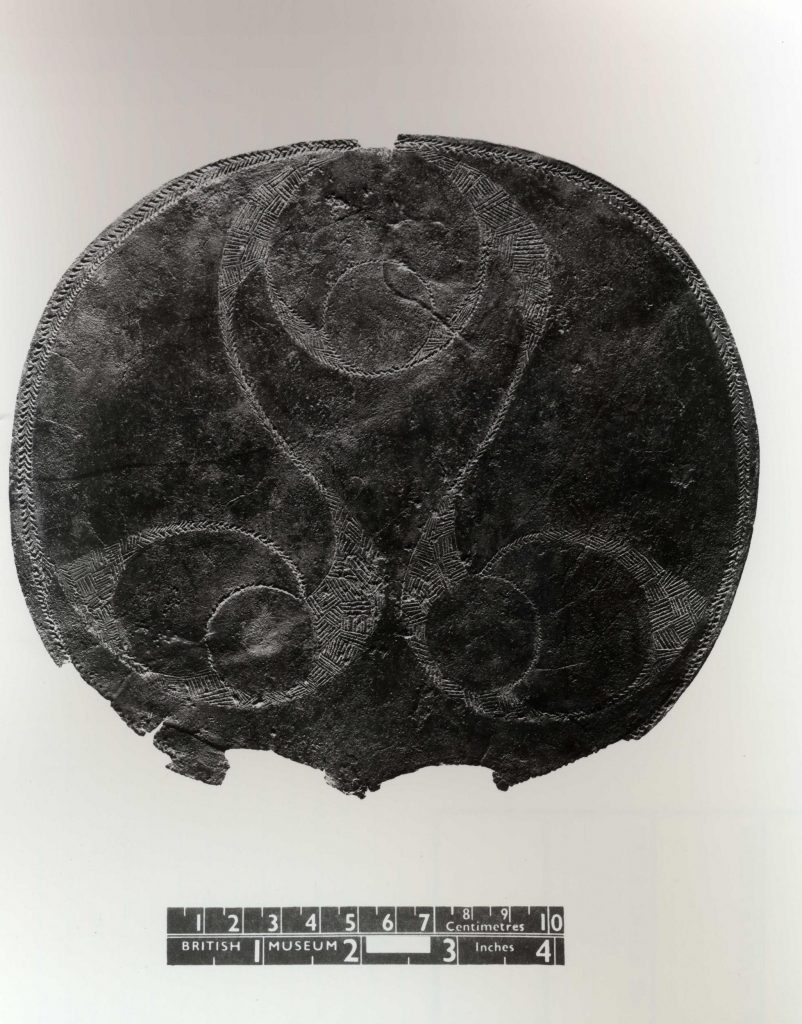
Unsurprising that British Iron Age mirrors fit within a broader tradition of magic, transformation, focus of power. 16
the handle
The handle combines aspects of several mirrors. Not simply for aesthetic reasons, but for function as well.
On one hand, I needed a good place to seat the opal. The Desborough Mirror has a nice round recess in the top of the handle which I felt could be easily developed to contain the opal I’d purchased, so that went into the pot.
I also needed a problem-solve a way to elegantly the backing at the midpoint of the mirror. The Dorton Mirror has three solid roundels with a sharp lip. I thought they’d be the perfect strong location through which I could thread a wire, one side of which to be anchored at the back and the other to be integrated into the red bead decoration. So I placed two on my hand, one at either side.
(The arch which sweeps over the opal and connects the two roundels is also taken from the Desborough Mirror.)


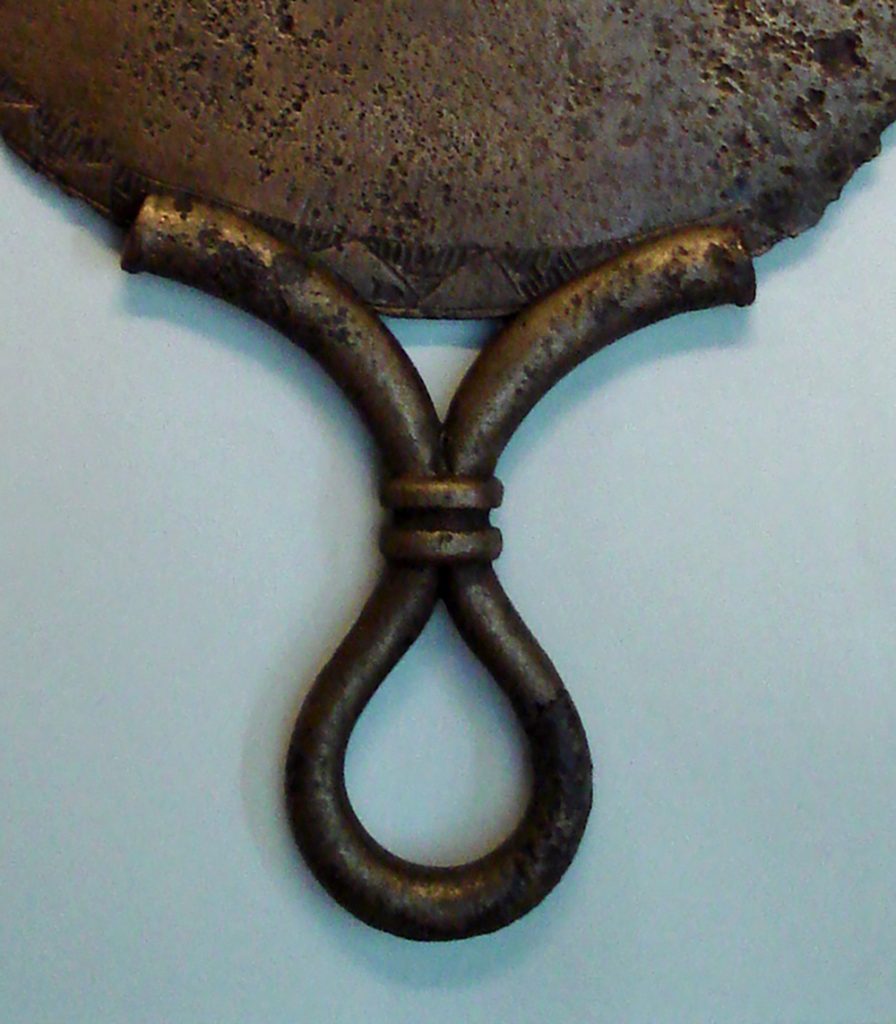
The loop for the bottom is common, to the point of being diagnostic for British Iron Age mirrors; in fact, it’s so important to the use and design of these objects that there is evidence that this is how the mirror was toted around or hung up for display. 17. And the raised moulding gathering the loops is quite like that of the St. Keverne Mirror, but honestly it’s such a common design feature of these mirrors it really could have come from any number of them. After all, it functioned for them much as it functions for me: to visually gather together the strands of the handle, if not physically gather them as well. (It also provided me another attachment point for the back.)
the construction
To call myself a novice bronzeworker would be an insult to bronzeworkers.
This was my first project, and my resources were also limited. As such, I didn’t feel capable of engraving a mirror face, nor do I have the space to cast a handle. (For more details of mirror construction see Rook, Lowery, Savage, and Wilkens (1982) 18 and Giles and Joy (2007) 19. Therefore I intended to go another way with my production techniques.
But this being such a new medium for me meant it took very little “oh dear, things have certainly gone awry” to force me into yet another completely different direction altogether. I’m grateful for all my experience with many other media, because it helped me roll with the punches when Plan A became Plan B and then Plan C. In the end, I employed modern technology to give me a leg up (a pen plotter fitted with a metal engraving point, which was its own separate journey), as well as my beadwork, wire wrapping, and sculpting skills.
The process wasn’t entirely divorced from period construction techniques, however; when sculpting the handle, I could almost imagine I was carving a wax from which I would cast it later (in my spacious and well-stocked imaginary workshop), and when I set the opal, I did in fact use the same bezel technique I would have used if I were setting it in a ring.
This piece involved even more problem-solving and strategizing than usual; it’s been a while since I’ve had a project that I kept rehearsing in my head when I was meant to be falling asleep.
But in the end, necessity was the mother of invention, and I think it came out way more interesting than what I’d originally planned.
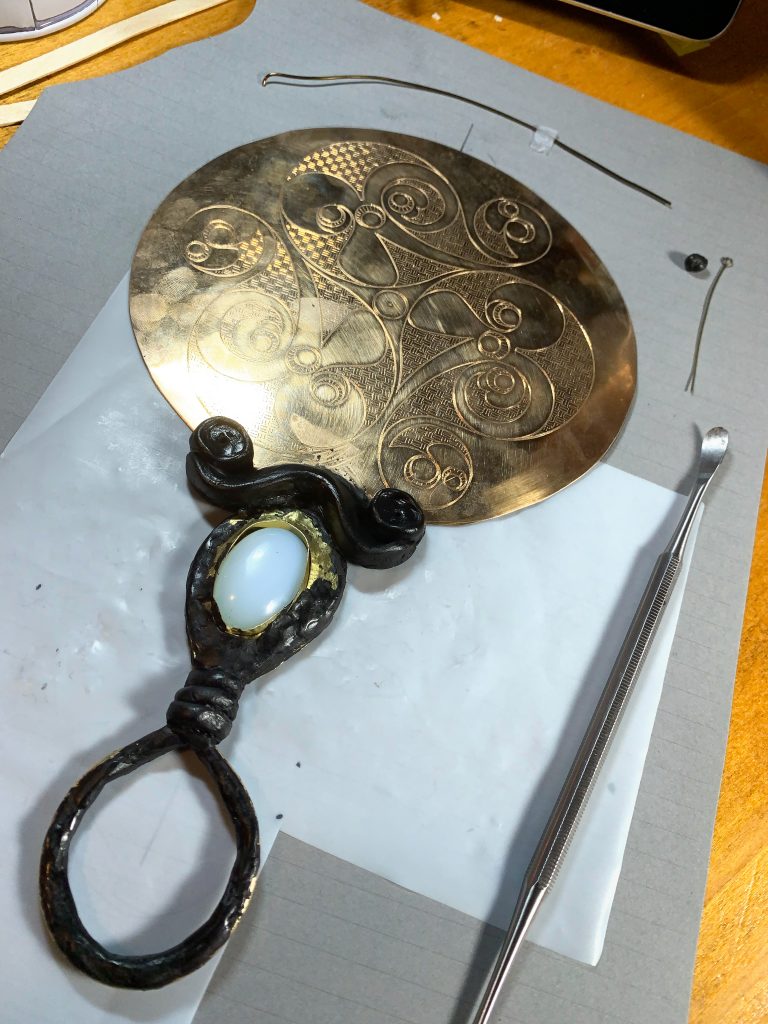
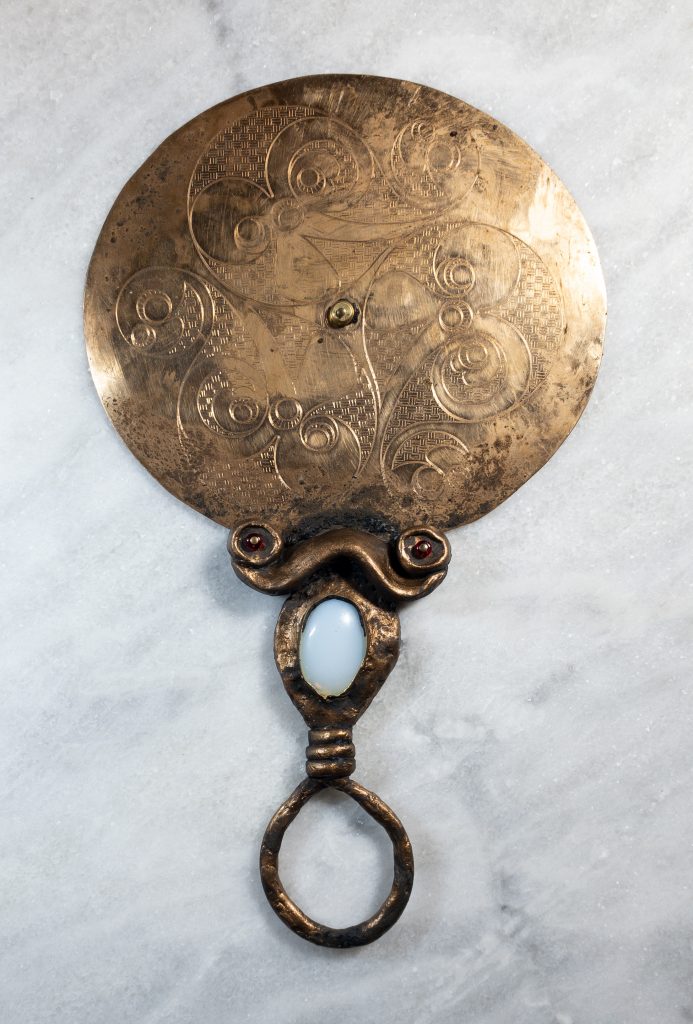
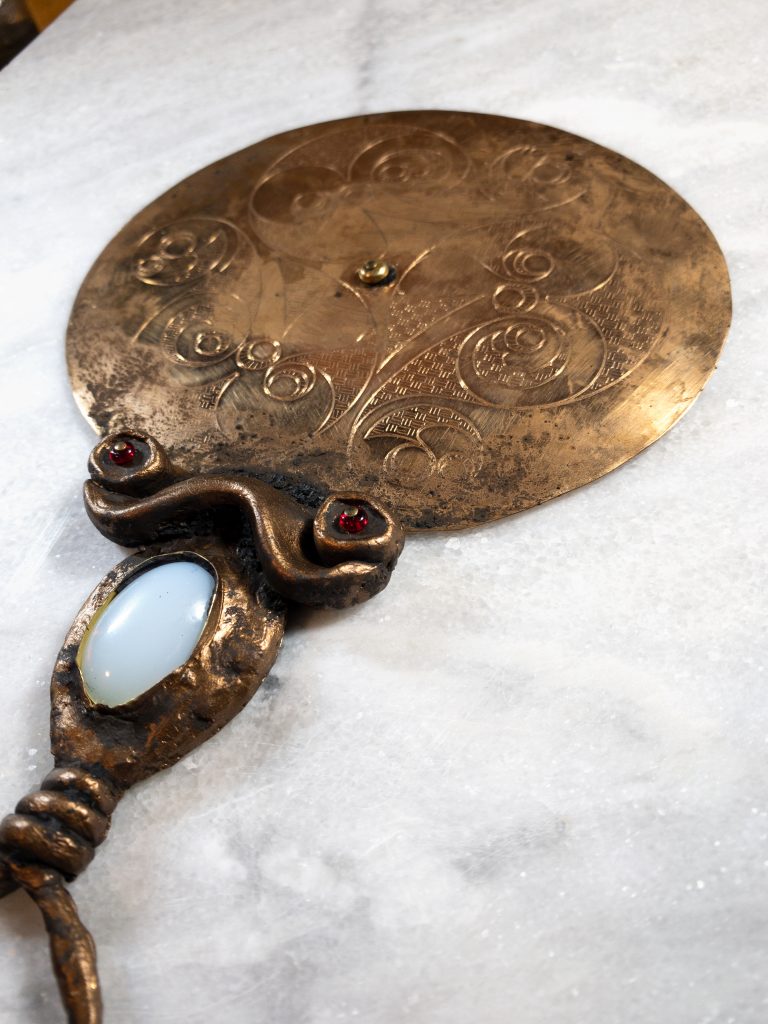
the colors
The sheet bronze I received from my supplier was beautiful but a little more coppery than the jeweller’s bronze wire I received a different vendor, stock which I had intended to use for the handle. However, one upshot to my plans being upended and my subsequent need to use metal coating from a bottle is that its color far better matched the plate than the wire did.
In fact, it matched perfectly.
Sometimes the universe provides.
It was also important to me to include a red accent to go along with the bronze. I might have used any number of other magical stones as an accent (carnelian was a popular option 20) but red alongside bronze is a color scheme which conveys at a glance the region we’re aiming for. The Holcomb Mirror itself features red glass on its handle, and Mary Davis writes 21, “The use of traditionally native colours employed with the use of bronze and bright red glass symbolised a strongly native British culture in opposition to Roman conquest and influence, one which later had a distinct impact on the future production of enamelled work that flourished in Roman Britain.”
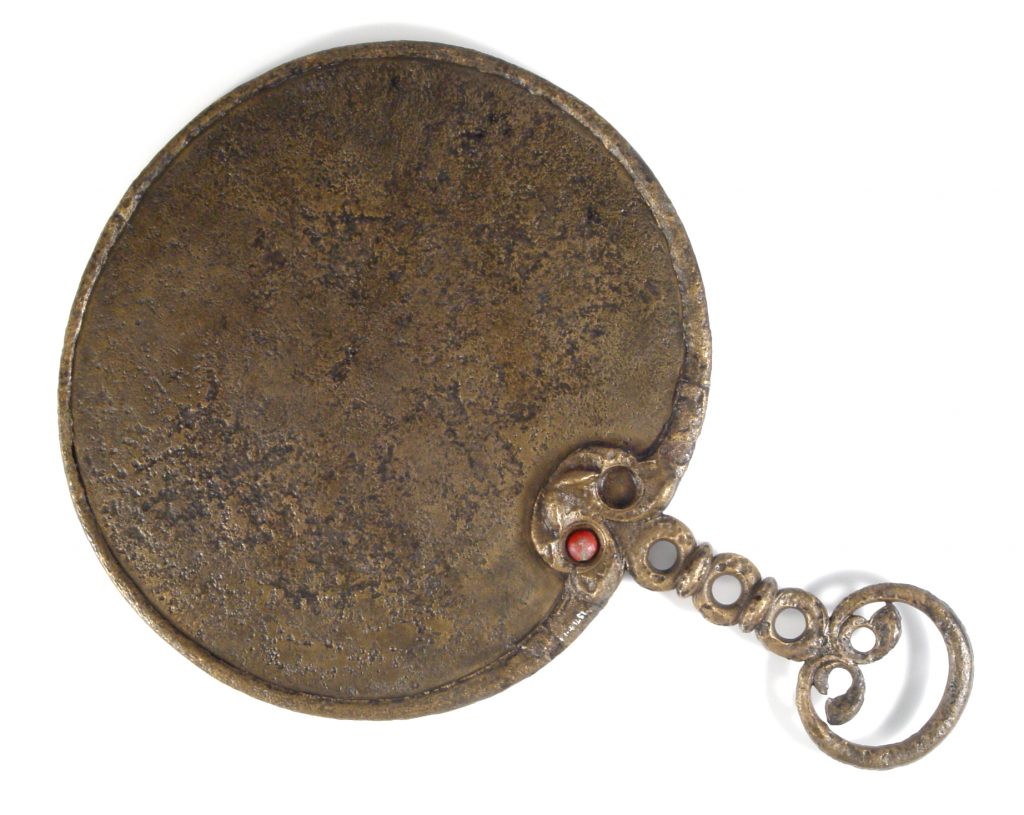
If you simply look at enough relevant artifacts, the regularity of the palette becomes obvious.
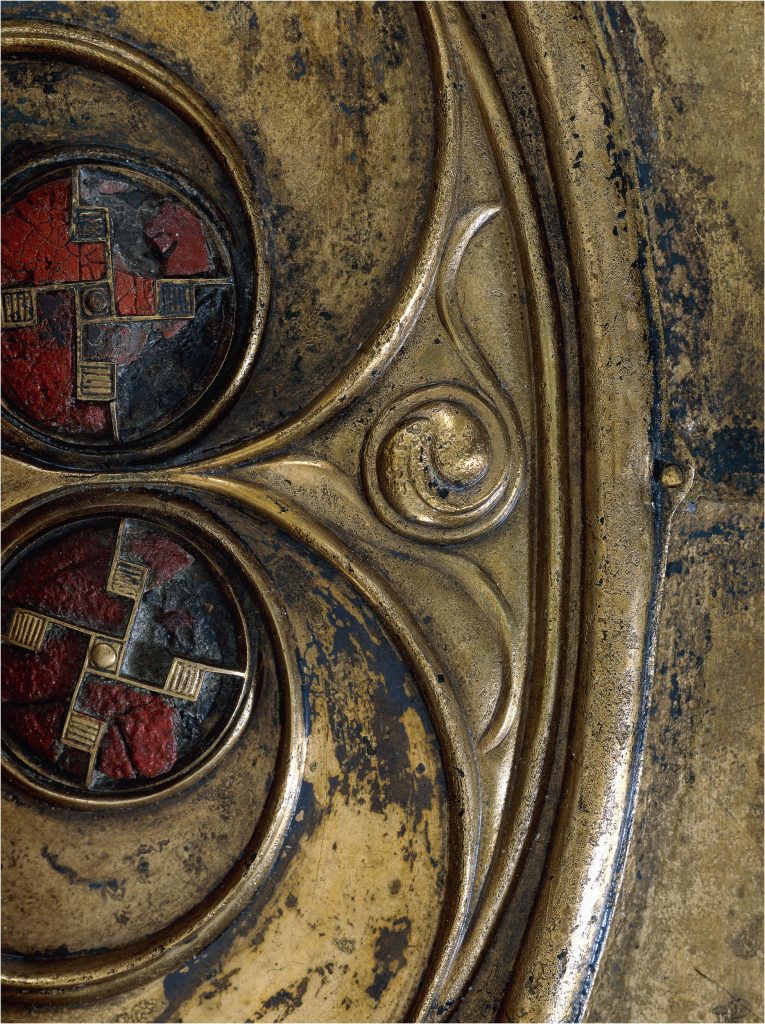
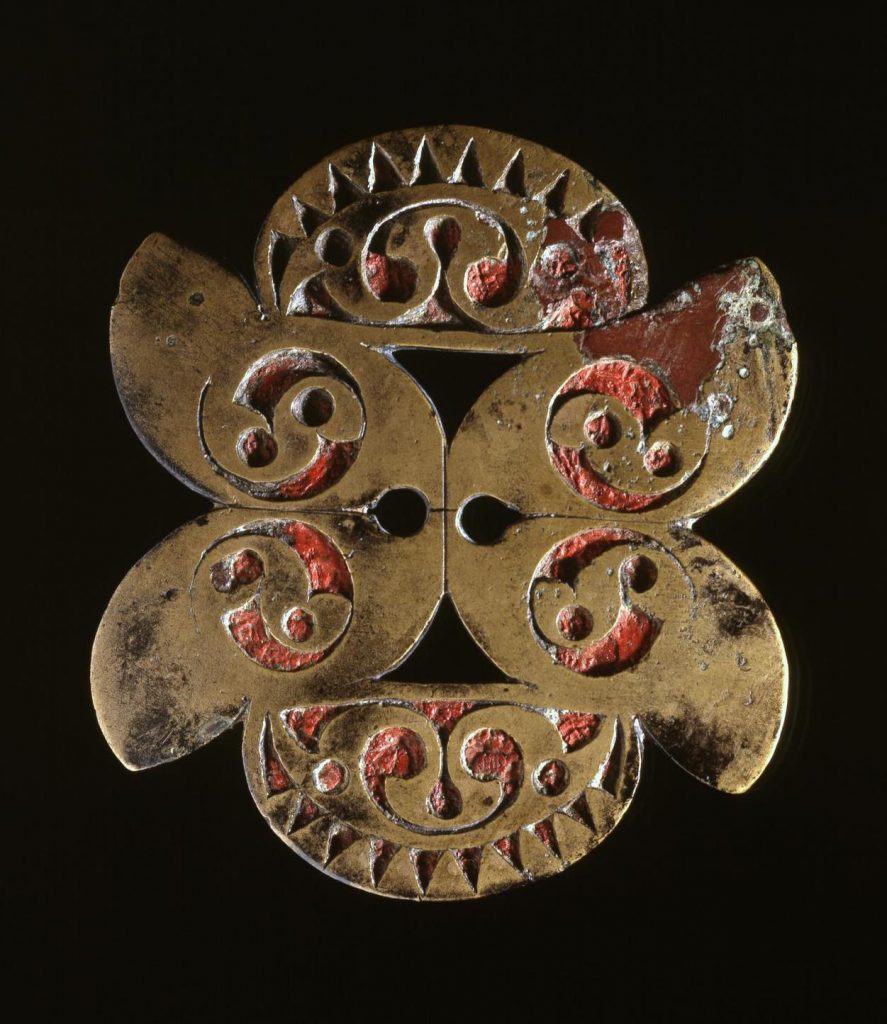
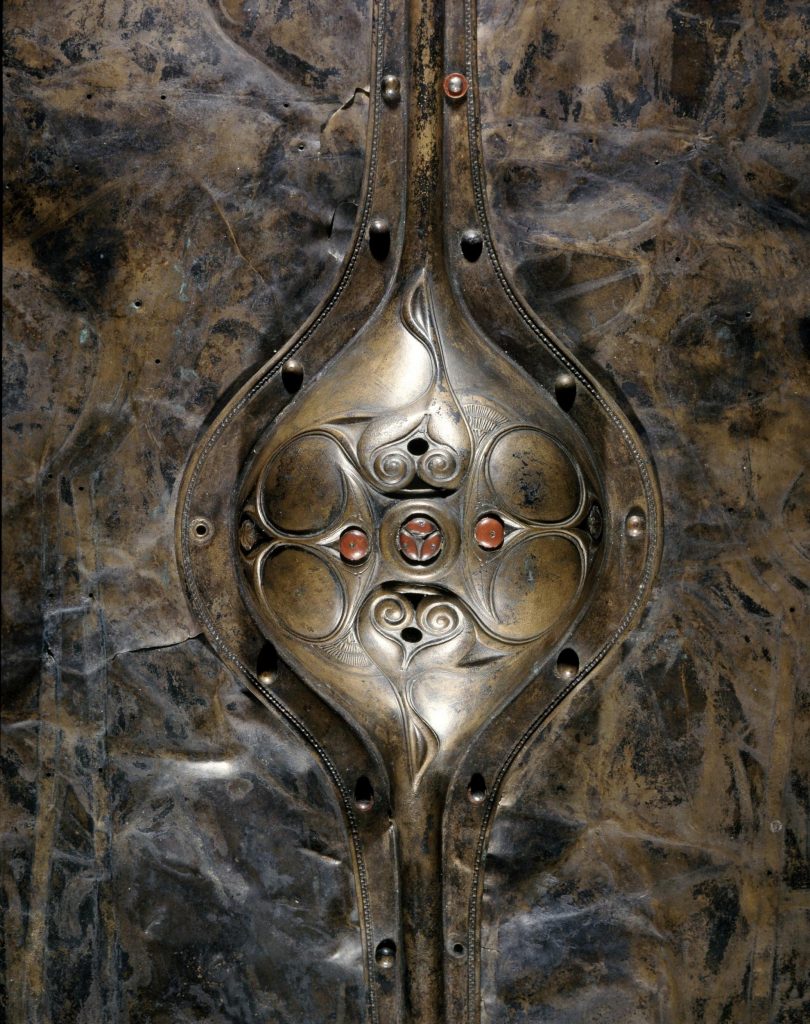
exhibitionist
In my scroll design classes, I’ve been calling a layout like this a “museum scroll”. (My degree is in museum design. It’s how my brain works.) Usually when doing so, however, I’m referring to a 2D rendering of an artifact alongside some scroll text.
Being an 3D object scroll makes this even more of a “museum scroll” than usual.

We’re also going to pretend that a well-funded museum would have better cleaned their artifacts. Maybe it’s not a well-funded museum? Maybe it’s a small and scrappy upstart of an establishment? It would certainly explain why its furniture is made of wire; if this really were a museum display, I’d have used plexiglass mounting brackets or something that made it clear (no pun intended) that the attachment points were exhibit furniture, not part of the artifact.
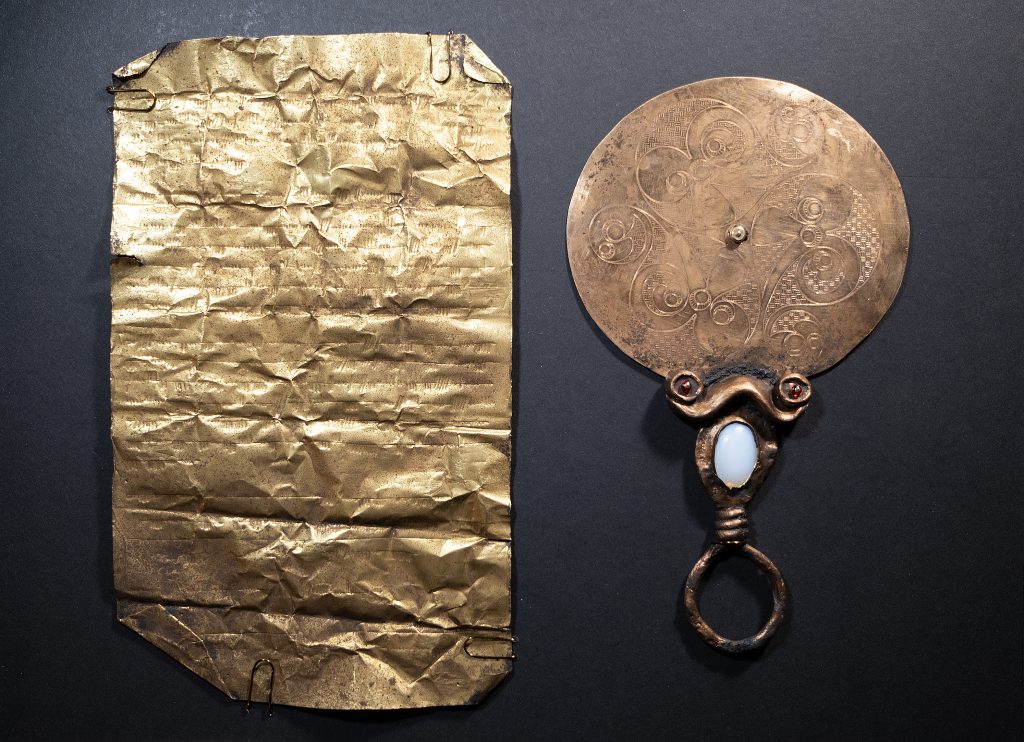
But I was acutely aware that this was going to be hoisted around and shifted and tilted, and again my resources were limited, so I had to concoct something more stable. Therefore the boss in the center the mirror was a concession to mounting, the wire going around the handle was a concession to mounting, and the wire brackets in the corners of the lamella were a concession to mounting.
Needs must. Museums need funding.
The lamella was placed on the left solely in deference to our English reading order, and the mirror was placed plate side up (rather than handle-side-up) because the orientation instinctively felt more active, like a tool for working magic, rather than hanging or at rest.
(It was also clear that framing is not my core competency. After twenty minutes of patiently and meticulously fighting the dust inside and outside the frame, I gave up. Sisyphus himself would have said fuck it. I know when I’ve been bested. Dust is part of the exhibit now. So mote it be.)

to wit:
I owe so many thanks to Jill G, who graciously volunteered to courier this award to the event and helped set some things to rights after a stressful journey through the USPS. I’m very, very grateful.
On a related note, for me this piece on the whole was an exercise in embracing imperfection. Almost none of my plans survived contact with reality. BUT. But the result has an organic energy and a realism that I wouldn’t have planned. (And as for the above, I also made a new friend.) In the end, it was all to the good.
Like art, service is never easy. It is never clean and breezy and unmarred. Nor should it be: if it were, it would not be as necessary. Or as valued.
Lanea’s contributions are necessary, valued, hard-fought, and generous, even beyond her peerage.
And that’s why she deserves this Opal.
references
[1] Giles, Melanie and Judy Joy. “Mirrors in the British Iron Age: performance, revelation and power.” _The Book of the Mirror. An Interdisciplinary Collection Exploring the Cultural Story of the Mirror._ Ed. M. Anderson. Newcastle : Cambridge Scholars Press, 2007. pp8-11
[2] “Uley 2,” Curse Tablets From Roman Britain, last accessed 28 August 2022, http://curses.csad.ox.ac.uk/4DLINK2/4DACTION/WebRequestCurseTabletSearch?searchType=latin-index&searchField=CSAD_ID&thisListPosition=0&displayImage=1&displayLatin=1&displayEnglish=1&searchTerm=uley-2.
[3] “Uley 43,” Curse Tablets From Roman Britain, last accessed 28 August 2022, http://curses.csad.ox.ac.uk/4DLINK2/4DACTION/WebRequestCurseTabletSearch?searchType=latin-index&searchField=CSAD_ID&thisListPosition=0&displayImage=1&displayLatin=1&displayEnglish=1&searchTerm=uley-43
[4] Juraj Franek and Daniela Urbanová. “As Isis Loved Osiris, So Let Matrona Love Theodoros…: Sympathetic Magic and Similia Similibus Formulae in Greek and Latin Curse Tablets (Part 2)” _Philologia Classica_ 14, no. 2 (2019): pp. 198-199
[5] Roy Kotansky. “Two Amulets in the Getty Museum: A Gold Amulet for Aurelia’s Epilepsy, An Inscribed Magical-Stone for Fever, “Chills,” and Headache,” _The J. Paul Getty Museum Journal_ Vol. 8 (1980): pp. 181-188
[6] Roy Kotansky. “Incantations and Prayers for Salvation on Inscribed Greek Amulets”, in _Magika Hiera: Ancient Greek Magic and Religion_, ed. D. Obbink & C. A. Faraone (Oxford: Oxford University Press, 1991), pp. 107-137,
[7] Roy Kotansky, “Greek Magical Amulets: the inscribed gold, silver, copper and bronze lamellae (Part I: Published Texts of Known Provenance)”, _Papyrologica Coloniensia_ Vol. 22 no 1, Opladen: Westdeutscher Verlag, 1994.
[8] Andrea Barta, “Some Remarks on the Latin Curse Tablets from Pannonia” _Acta Antiqua_ 59 (1–4) (September 2020): pp561–564 http://dx.doi.org/10.1556/068.2019.59.1-4.49
[9] “Cursing and Cursive: languages”, Curse Tablets From Roman Britain, last accessed 28 August 2022, http://curses.csad.ox.ac.uk/beginners/cursive-languages.shtml
[10] Kotansky, “Greek Magical Amulets,” 7.
[11] Jody Joy, _Iron Age Mirrors: A Biographical Approach_ BAR British Series 518 (Oxford: British Archeological Reports, 2010), 30.
[12] Joy, _Iron Age Mirrors_, 24.
[13] Joy, _Iron Age Mirrors_, 25–38.
[14] Giles and Joy, “Mirrors in the British Iron Age”, 7.
[15] Tony Rook, P.R. Lowery, R.D.A. Savage, and R.L. Wilkins, F.S.A. “An Iron Age Bronze Mirror From Aston, Hertfordshire.” _The Antiquaries Journal_ 62, No.1 (March 1982); 27.
[16] Giles and Joy, “Mirrors in the British Iron Age”, 8–11.
[17] Giles and Joy, “Mirrors in the British Iron Age”, 8.
[18] Tony Rook et al., “Iron Age Mirror”, 23–33.
[19] Giles and Joy, “Mirrors in the British Iron Age”, 4–5.
[20] Roy D. Kotansky, “Textual Amulets and Writing Traditions in the Ancient World,” in _Guide to the Study of Ancient Magic_, ed. David Frankfurter (Leiden: Brill, 2019), 516.
[21] Mary Davis, “‘Sealing wax’ red glass in Late Iron Age Britain”, _PAST: The Newsletter of the Prehistoric Society_ 86 (Summer 2017): 5–7.

